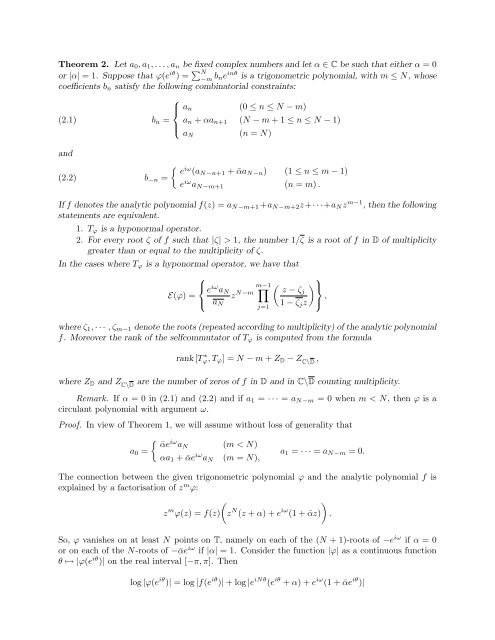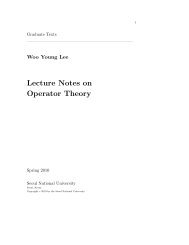ON HYPONORMAL TOEPLITZ OPERATORS WITH POLYNOMIAL ...
ON HYPONORMAL TOEPLITZ OPERATORS WITH POLYNOMIAL ...
ON HYPONORMAL TOEPLITZ OPERATORS WITH POLYNOMIAL ...
You also want an ePaper? Increase the reach of your titles
YUMPU automatically turns print PDFs into web optimized ePapers that Google loves.
Theorem 2. Let a 0 , a 1 , . . . , a n be fixed complex numbers and let α ∈ C be such that either α = 0<br />
or |α| = 1. Suppose that ϕ(e iθ ) = ∑ N<br />
−m b ne inθ is a trigonometric polynomial, with m ≤ N, whose<br />
coefficients b n satisfy the following combinatorial constraints:<br />
⎧<br />
⎪⎨ a n (0 ≤ n ≤ N − m)<br />
(2.1) b n = a n + αa n+1 (N − m + 1 ≤ n ≤ N − 1)<br />
⎪⎩<br />
a N (n = N)<br />
and<br />
{ e iω (a N−n+1 + ᾱa N−n ) (1 ≤ n ≤ m − 1)<br />
(2.2) b −n =<br />
e iω a N−m+1 (n = m) .<br />
If f denotes the analytic polynomial f(z) = a N−m+1 +a N−m+2 z+· · ·+a N z m−1 , then the following<br />
statements are equivalent.<br />
1. T ϕ is a hyponormal operator.<br />
2. For every root ζ of f such that |ζ| > 1, the number 1/ζ is a root of f in D of multiplicity<br />
greater than or equal to the multiplicity of ζ.<br />
In the cases where T ϕ is a hyponormal operator, we have that<br />
⎧<br />
⎨<br />
e iω a N<br />
E(ϕ) =<br />
⎩ a N<br />
m−1<br />
∏<br />
z N−m<br />
j=1<br />
( z − ζj<br />
1 − ζ j z<br />
) ⎫ ⎬<br />
⎭ ,<br />
where ζ 1 , · · · , ζ m−1 denote the roots (repeated according to multiplicity) of the analytic polynomial<br />
f. Moreover the rank of the selfcommutator of T ϕ is computed from the formula<br />
rank [T ∗ ϕ, T ϕ ] = N − m + Z D − Z C\D<br />
,<br />
where Z D and Z C\D<br />
are the number of zeros of f in D and in C\D counting multiplicity.<br />
Remark. If α = 0 in (2.1) and (2.2) and if a 1 = · · · = a N−m = 0 when m < N, then ϕ is a<br />
circulant polynomial with argument ω.<br />
Proof. In view of Theorem 1, we will assume without loss of generality that<br />
{ ᾱe iω a N (m < N)<br />
a 0 =<br />
αa 1 + ᾱe iω a N (m = N),<br />
a 1 = · · · = a N−m = 0.<br />
The connection between the given trigonometric polynomial ϕ and the analytic polynomial f is<br />
explained by a factorisation of z m ϕ:<br />
(<br />
)<br />
z m ϕ(z) = f(z) z N (z + α) + e iω (1 + ᾱz) .<br />
So, ϕ vanishes on at least N points on T, namely on each of the (N + 1)-roots of −e iω if α = 0<br />
or on each of the N-roots of −ᾱe iω if |α| = 1. Consider the function |ϕ| as a continuous function<br />
θ ↦→ |ϕ(e iθ )| on the real interval [−π, π]. Then<br />
log |ϕ(e iθ )| = log |f(e iθ )| + log |e iNθ (e iθ + α) + e iω (1 + ᾱe iθ )|













